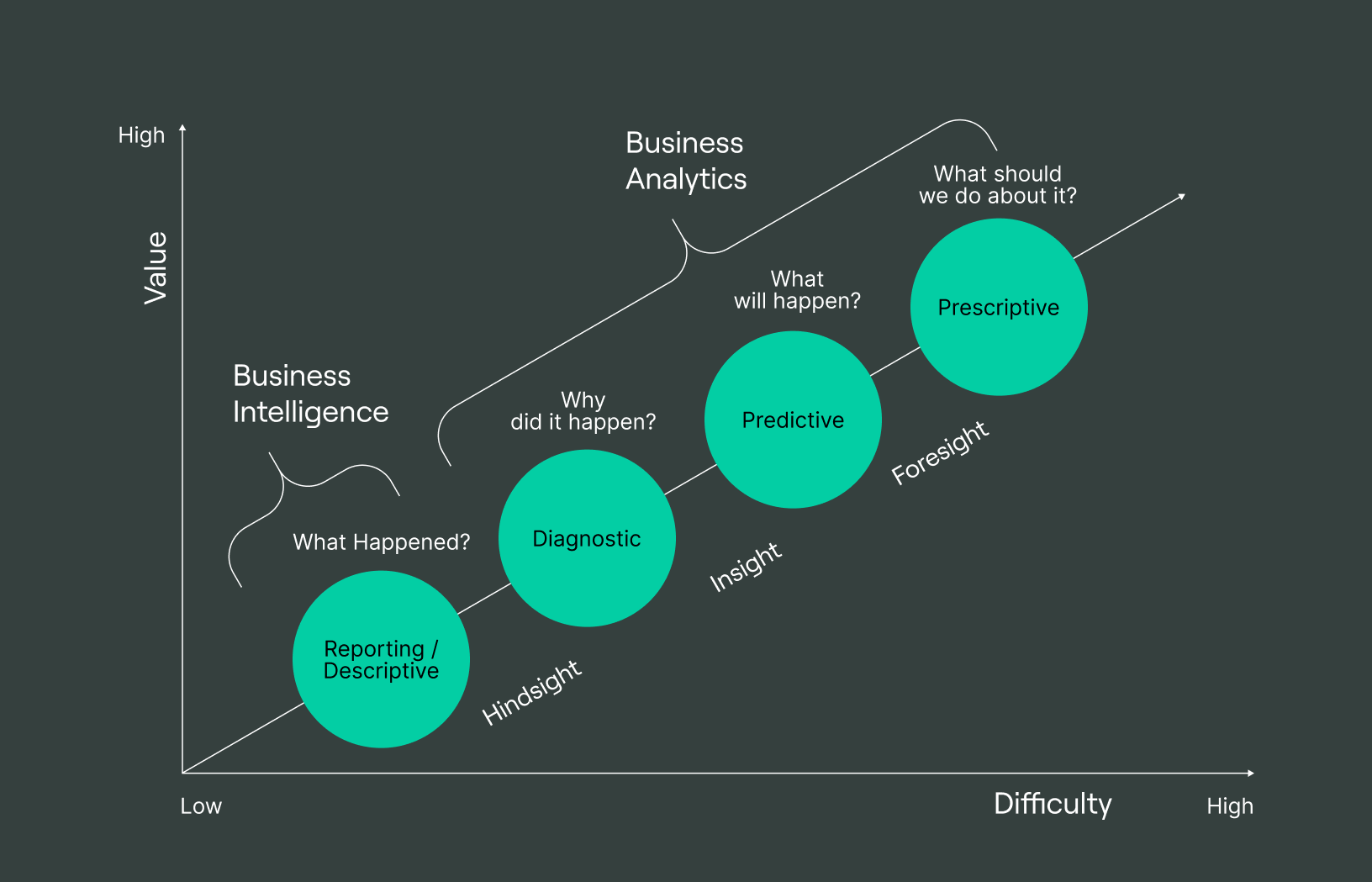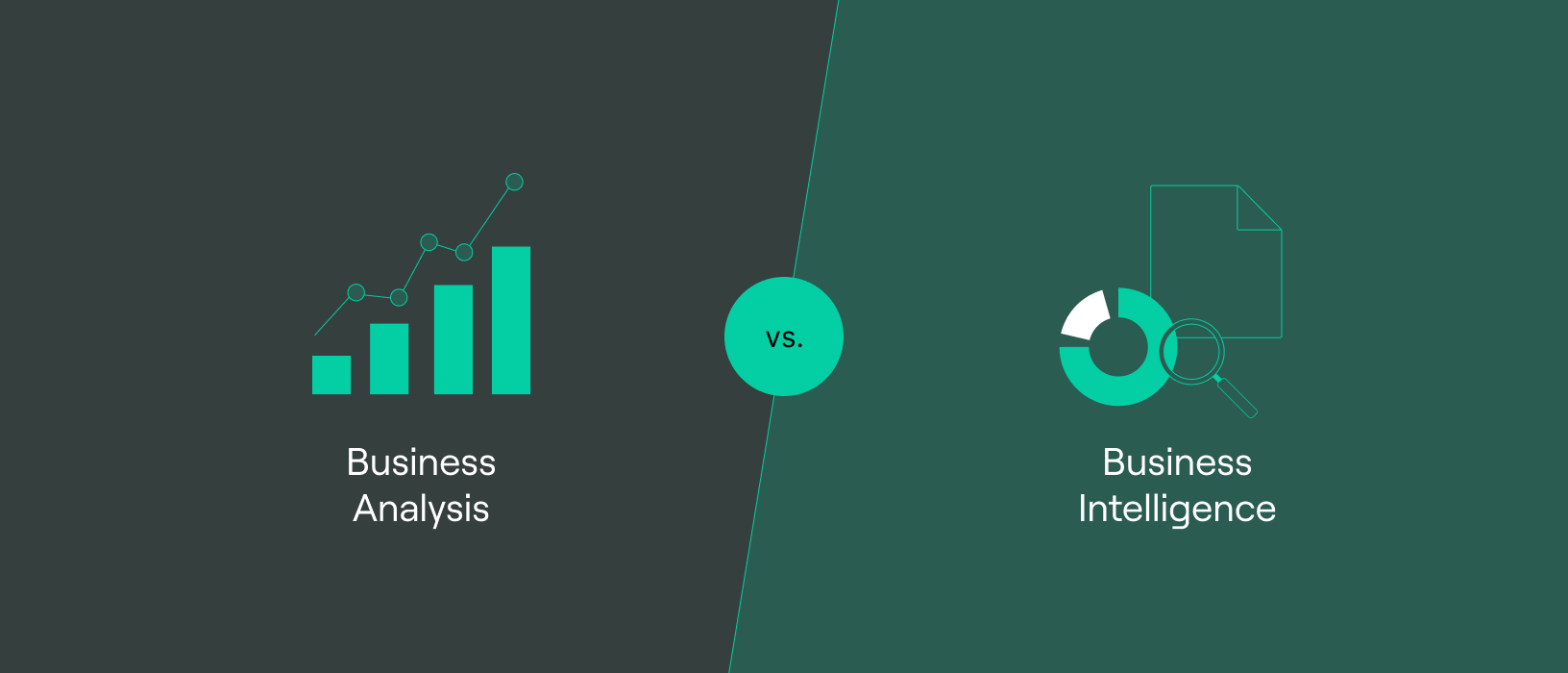
Business intelligence vs. business analytics: The comparison guide
In today’s data-driven landscape, organizations rely on analytics to make informed decisions and drive growth. Business Intelligence (BI) and Business Analytics (BA) are two approaches that play a significant role in this process. While these terms are often used interchangeably, it’s important to understand their unique differences and applications.
This comprehensive guide aims to compare BI and BA, exploring their focus, data types, tools, goals, implementation, applications, jobs, and organizational size. By examining these aspects, we will gain a clear understanding of the distinctions between BI and BA and their respective value in organizations. Let’s delve into the key difference between Business Intelligence vs. Business Analytics and uncover the nuances of these data-driven approaches.
What is Business Intelligence?
Business intelligence (BI) is a group of methods, tools, and procedures used by businesses to analyze, decipher, and produce actionable insights from massive amounts of data. Data from various sources, including databases and data warehouses, must be gathered, arranged, and analyzed.
The main goal of BI is to enable data-driven decision-making by giving decision-makers a thorough understanding of business performance. Extracting useful information from raw data includes processes like data integration, cleansing, and transformation. Reports, dashboards, and visualizations are then used to present this data for easy analysis.
Data collection, modelling, analysis, and visualization are all included in BI. It gives businesses the ability to track key performance indicators, spot trends, and learn more about consumer behaviour, market trends, and financial performance.
Users can interact with data, explore it from various angles, and find hidden insights using BI tools and platforms. These self-service features enable business users to create reports and conduct data analysis without the assistance of IT or data specialists.
BI gives businesses the ability to make the right decisions, increase operational effectiveness, spot growth prospects, and gain a competitive edge. It provides the framework for insightful decision-making in the fast-paced business environment of today.
Types of Business Intelligence
-
Descriptive BI: Summarizes historical data through reports, dashboards, and visualizations to monitor performance trends.
-
Diagnostic BI: Analyzes data to uncover underlying causes of specific events or trends.
-
Predictive BI: Utilizes statistical models and forecasting techniques to make future predictions based on historical and real-time data.
-
Prescriptive BI: Provides recommendations and actionable insights to optimize decision-making using advanced algorithms and machine learning.
-
Self-service BI: Empowers business users to access and analyze data independently through user-friendly tools and platforms.
-
Real-time BI: Analyzes and reports data as it is generated, allowing immediate decision-making.
-
Spatial BI: Integrates geographical data into analysis, enabling visualization and insight generation based on geographic context.
Tools and techniques for Business Intelligence
-
Data warehousing: Gathering and consolidating data from different sources into a central repository for efficient storage and retrieval.
-
Extract, Transform, Load (ETL): Extracting, transforming, and loading data into the data warehouse, ensuring data consistency and quality.
-
Online analytical processing (OLAP): Multidimensional analysis of data, enabling users to explore information from different perspectives.
-
Data mining: Using statistical algorithms and machine learning to discover patterns and insights within large datasets.
-
Data visualization: Present complex data through intuitive charts and graphs for better understanding and communication.
-
Reporting and dashboards: Creating formatted reports and visual overviews of key metrics for monitoring and analysis.
-
Data discovery and self-service BI: Empowering business users to independently explore and analyze data through user-friendly interfaces.
-
Mobile BI: Accessing and interacting with BI applications and reports on mobile devices for real-time decision-making.
-
Text mining and NLP: Extract insights from unstructured textual data using sentiment analysis and topic modelling techniques.
-
Cloud-based BI: Storing, managing, and accessing data and analytics tools in the cloud for scalability and collaboration.
Key benefits of Business Intelligence
Businesses can benefit greatly from business intelligence (BI). It improves operational effectiveness, encourages data-driven decision-making, and boosts business performance. By identifying market trends and customer preferences, BI offers a competitive edge. It makes it possible for staff members to perform self-service analytics and real-time monitoring. Data governance, security, and regulatory compliance are all ensured by BI. In general, BI enables businesses to effectively use data, gain insights, and make decisions, which improves performance and success in the data-centric business environment of today.
Challenges of Business intelligence
-
Data quality and Integration: Ensuring accurate and consistent data from various sources and resolving discrepancies is a complex task, requiring thorough data cleansing and transformation.
-
Data security and privacy: Safeguarding sensitive data and adhering to privacy regulations pose challenges, demanding robust security measures and governance frameworks.
-
Organizational resistance and culture: Overcoming resistance to a data-driven culture, promoting data literacy, and encouraging the adoption of BI tools require effective change management strategies.
-
Scalability and performance: Efficiently handling and processing large datasets, ensuring timely insights, and maintaining system performance become challenges as data volumes grow.
-
Data governance and management: Establishing governance frameworks, defining data ownership, standardization, and maintaining data quality over time require careful planning and execution.
-
User adoption and training: Encouraging user adoption of BI tools and providing adequate training is crucial for maximizing their value.
-
Complexity of analysis: Extracting meaningful insights from complex data demands advanced analytical techniques and data science skills.
-
Cost and return on investment: Managing the costs of implementing BI solutions while ensuring a favourable return on investment and alignment with strategic goals is essential.
What is business analytics?
Business analytics involves using data, statistical analysis, and quantitative methods to derive insights and make informed business decisions. It requires analyzing, visualizing, and exploring data to find trends and patterns that inform strategic decisions. Organizations can gain useful insights from sizable datasets by using techniques like data mining and predictive modelling.
Business analytics promotes innovation, improves customer understanding, streamlines operations, and allows for seamless decision-making driven by data. Descriptive, diagnostic, predictive, and prescriptive analytics are all part of business analytics that equips organizations to use data to gain a competitive edge, expand, and accomplish strategic objectives.
Types of business analytics
-
Descriptive analytics: Descriptive analytics focuses on analyzing historical data to understand past events, trends, and patterns. It provides a retrospective view, laying the foundation for further analysis.
-
Diagnostic analytics: Diagnostic analytics dives deeper into data to identify the causes and reasons behind specific events or trends. It helps uncover relationships and key factors that contribute to outcomes.
-
Predictive analytics: Predictive analytics leverages historical and real-time data to forecast future outcomes and trends. It utilizes statistical modelling and machine learning algorithms to make predictions, enabling proactive decision-making.
-
Prescriptive analytics: Prescriptive analytics goes beyond prediction by recommending optimal actions based on data analysis. It employs advanced algorithms and simulations to guide organizations toward the best course of action.
-
Diagnostic-predictive-prescriptive (DPP) analytics: DPP analytics combines diagnostic, predictive, and prescriptive analytics to provide a comprehensive approach.
Tools and techniques for business analytics
-
Data mining: Employing statistical algorithms and machine learning methods, data mining uncovers hidden patterns and relationships within extensive datasets.
-
Statistical analysis: Statistical analysis applies statistical methods to examine data, detect trends, and draw meaningful conclusions, facilitating informed decision-making.
-
Predictive modeling: By utilizing historical data and statistical algorithms, predictive modelling creates models that forecast future outcomes, enabling proactive decision-making.
-
Data visualization: Data visualization tools and techniques transform complex data into visually engaging representations, enhancing understanding and aiding in the effective communication of insights.
-
Machine learning: Machine learning algorithms enable computers to learn patterns from data, facilitating predictions and actions without explicit programming.
-
Text analytics: Text analytics techniques extract insights from unstructured textual data, such as sentiment analysis and topic modelling, helping users understand customer opinions and trends.
-
Optimization techniques: Optimization techniques identify optimal solutions by considering constraints and objectives, enabling organizations to optimize resources and processes.
-
Simulation: Simulation creates virtual models to replicate real-world scenarios, which allows organizations to test hypotheses, evaluate strategies, and make well-informed decisions.
Key benefits of business analytics
-
Decision making: Business analytics enables informed decision-making based on data and insights, leading to improved outcomes and efficiency.
-
Enhanced operational efficiency: Organizations can identify and optimize operational inefficiencies, streamlining processes and resource allocation by analyzing data.
-
Deeper customer understanding: Business analytics provides insights into customer behaviour, preferences, and needs, enabling personalized marketing and improved customer experiences.
-
Competitive edge: Leveraging analytics helps organizations stay ahead of competitors by identifying trends, conducting competitor analysis, and predicting customer demands.
-
Risk mitigation: Analytics aids in identifying and mitigating risks, and optimizing risk management strategies.
-
Innovation and growth: Analytics uncovers new opportunities, fostering innovation and driving business growth.
-
Real-time monitoring and agility: Analytics enables real-time monitoring, facilitating agile decision-making and rapid responses to market changes.
Challenges of business analytics
-
Data quality and integration: Ensuring accurate and consistent data from multiple sources poses a challenge, requiring data integration and cleansing processes.
-
Data privacy and security: Safeguarding sensitive data and complying with privacy regulations necessitates robust security measures and privacy frameworks.
-
Skill gap and talent acquisition: Finding skilled analytics professionals with domain knowledge is challenging due to high demand.
-
Data governance and ethics: Establishing data governance frameworks and ensuring the ethical use of data require careful planning and implementation.
-
Change management and organizational Adoption: Promoting a data-driven culture requires managing resistance and fostering user adoption.
-
Technology and infrastructure: Managing scalable analytics infrastructure and utilizing advanced analytical techniques are essential.
-
Data complexity and interpretation: Analyzing complex datasets and interpreting unstructured data can be challenging.
-
Return on investment (ROI): Aligning analytics projects with business goals and measuring their impact to achieve favourable ROI is crucial.


DoubleCloud Visualization. Get insights with ChatGPT!
Don’t waste time reading numerous reports and manually analyzing data — rely on AI-Insights and get fast and accurate conclusions.
What is the difference between business intelligence and business analytics?
Focus and scope of analysis
Business intelligence (BI) is the study of historical data with the aim of producing reports and dashboards that track key performance indicators (KPIs) and give information about past and present business operations. It places a focus on monitoring and reporting business activity.
Business analytics (BA) focuses on using data to discover patterns, foresee trends, and take proactive actions. It entails investigating both historical and current data, spotting trends, and projecting future results. Predictive and prescriptive analysis are prioritized by BA to aid in strategic decision-making.
Data types and sources:
BI: The main focus of BI is on structured data from internal sources, including databases, spreadsheets, and transactional systems. It is concentrated on structured data analysis to offer operational insights.
BA: BA deals with a wider variety of data types, including structured, semi-structured, and unstructured data. To offer thorough insights, it combines data from internal and external sources, such as social media, customer reviews, and sensor data.
Tools and technologies
BI: For accurate data analysis and visualization, BI typically makes use of tools like reporting software, dashboards, and OLAP (Online Analytical Processing). It emphasizes the use of a user-friendly format for presenting data.
BA: BA uses cutting-edge analytics tools like predictive modelling methods, machine learning, statistical software, and data mining algorithms. It places a focus on advanced analytics, modelling, and data exploration capabilities.
Goals and outcomes
BI: The main objective of BI is to offer historical and current insights to track and optimize operational performance, increase productivity, and support daily decision-making.
BA: The primary objective of BA is to find patterns, trends, and insights in data to enable proactive decision-making, spot business opportunities, streamline procedures, and gain a competitive edge.
Implementation and integration
BI: BI is commonly used as a centralized system that combines data from various sources into a data warehouse or a data mart. It emphasizes the standardized and consolidated use of data.
BA: Applying BA requires the integration of data from a variety of sources, including internal and external data, cloud-based platforms, and real-time streaming sources. Data preparation, exploration, and integration are the main points of emphasis that support advanced analysis.
Applications
BI: BI is frequently used in fields like financial reporting, sales analysis, supply chain management, and operational performance monitoring.
BA: BA has broader applications, such as market research, customer segmentation, predictive maintenance, fraud detection, demand forecasting, and strategic decision-making.
Jobs
BI: Typical BI job roles include data analysts, reporting analysts, business intelligence developers, and data visualization specialists.
BA: Job titles associated with the BA degree include data scientists, business analysts, predictive analysts, data engineers, and machine learning specialists.
Organizational size
BI: BI is widely used by organizations of any size, from small businesses to big corporations, to monitor and optimize their operations.
BA: Larger organizations that have access to a variety of datasets and need advanced analytics capabilities for strategic decision-making are more likely to adopt BA.
Organizations may differentiate between BI and BA differently, and there may be overlaps between the two in terms of the tools and techniques employed. The details offered represent a broad distinction based on customary business procedures.
Examples of business intelligence and business analytics
Business intelligence (BI) examples:
-
Sales analysis: BI tools can generate reports and dashboards to analyze sales performance, track revenue, monitor customer trends, and identify opportunities for growth.
-
Financial reporting: BI solutions can consolidate financial data from various sources, and generate balance sheets, income statements, and cash flow reports, enabling organizations to gain insights into their financial performance.
-
Supply chain management: BI helps optimize the supply chain by providing visibility even at inventory levels, demand patterns, and supplier performance. It allows organizations to identify bottlenecks, reduce costs, and improve delivery times.
-
Customer relationship management (CRM): BI tools integrated with CRM systems analyze customer data, enabling businesses to track customer interactions, identify buying patterns, and personalize marketing campaigns.
Business analytics (BA) Examples:
-
Predictive maintenance: BA techniques use historical equipment data, sensor data, and machine learning algorithms to predict equipment failures, enabling proactive maintenance and minimizing downtime.
-
Market segmentation: BA helps identify distinct customer segments based on demographics, behaviours, and preferences. This information allows organizations to tailor their marketing strategies and offerings to specific customer groups.
-
Fraud detection: BA techniques analyze transactional data and identify patterns of fraudulent activities, enabling organizations to detect and prevent fraudulent transactions and safeguard against financial losses.
-
Pricing optimization: BA models analyze market trends, competitor pricing, customer behaviour, and demand patterns to optimize pricing strategies, maximizing revenue and profitability.
Final words
Businesses that want to effectively use data-driven insights must understand the differences between business intelligence (BI) and business analytics (BA).
In order to maximize efficiency, BI focuses on tracking and reporting past and present operational performance. The use of advanced analytics techniques by BA, on the other hand, enables proactive decision-making and strategic planning by gaining insights from a wider variety of data sources and types.
Benefits like effective decision-making, improved operational efficiency, enhanced customer understanding, and competitive advantage are available by both BI and BA. However, putting these strategies into practice has drawbacks in terms of organizational adoption, talent acquisition, privacy, and data quality.
Organizations must prioritize data integrity by ensuring accurate, complete, and secure data to overcome these obstacles. The right technology infrastructure, competent analytics teams, and strong data governance frameworks are crucial.
Businesses that successfully combine business Intelligence and Business Analytics, placing an emphasis on data integrity and talent development, will gain a competitive edge, spur innovation, and promote sustainable growth in this era of data. For organizations across industries, embracing the power of data analytics is not only a necessity but also a strategic move in the right direction.
DoubleCloud provides building blocks to help companies achieve their goals both on the BI and BA landscapes in a cost effective and helping short the time to insights.
Start your trial today




